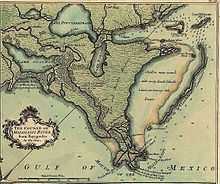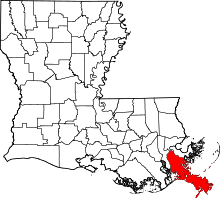La Balize, Louisiana
| La Balize | |
| Historical | |
| Nickname: Pilotsville | |
| Country | United States |
|---|---|
| State | Louisiana |
| Parish | Plaquemines |
| Coordinates | 29°07′21″N 89°06′26″W / 29.12250°N 89.10722°WCoordinates: 29°07′21″N 89°06′26″W / 29.12250°N 89.10722°W |


La Balize, Louisiana, was the first French fort and settlement near the mouth of the Mississippi River, in what later became Plaquemines Parish. The village's name (also spelled La Balise) meant "seamark." Inhabited by 1699, La Balize was possibly the oldest French settlement within the current boundaries of Louisiana. Historically and economically important for overseeing the river, it was rebuilt several times because of hurricane damage.[1] The active delta lobe of the river's mouth is called the Balize Delta, after the settlement, or the Birdfoot Delta, because of its shape.
La Balize was inhabited chiefly by fishermen, river pilots, and their families. The pilots were critical to helping ships navigate to and from the port of New Orleans through the shifting passages, currents, and sandbars of the river's delta front. The village was vulnerable to seasonal hurricanes. Washed away in a hurricane of 1740, the village was rebuilt on the newly-emerged island of San Carlos.[1] That village in turn was damaged severely several times and finally destroyed.
By 1853 also called Pilotsville, the village of La Balize was rebuilt about five miles (8 km) to the northwest in the Southwest Pass, on the west bank of the Mississippi.[2] That village was taken down by wind and a storm surge of the September 14–15 hurricane of 1860.[3] La Balize was abandoned, and a new pilots' settlement was constructed about five miles (8 km) upriver on the east bank of the Mississippi, just above the Head of the Passes. The new village was named Pilottown.
History
When the explorer Robert de La Salle claimed the land in 1682 for the French crown, he identified this site near the mouth of the Mississippi as important. It was at a point just above two major forks in the river, so passage could be controlled. By 1699 the first settlers inhabited a "rude little fort" built in the marshes, making this one of the oldest settlements in the colony.[1] A map drawn about 1720 showed the mouth of the Mississippi with the different forks of the river, and the isle and fort of La Balize.[4] By 1721 the French had constructed a 62-foot (19 m)-high wooden pyramid as la balize at the settlement.[1] It sat relatively high above the mud and marshes of the delta wetlands.
By 1718 the center of the French colony was in New Orleans. In the early 18th century, the Roman Catholic Church quickly established seven pioneer parishes in the Louisiana colony, among them the parish at La Balize, founded in 1722. The French also founded four pioneer parishes in early villages of what are now Mississippi and Alabama.[5] After the establishment of La Balize, the King commissioned Nicolas Godefroy Barbin to serve as the "Garde Magazin" (chief administrator) there. That commission, signed in 1703 by the King and his minister Jérôme Phélypeaux comte de Pontchartrain, was significant in that it recognized the strategic importance of La Balize.[6]
Despite the vulnerability of the low-lying site to hurricanes, the French and later settlers needed to control the mouth of the Mississippi and have a place where pilots could meet the ships. They always rebuilt. The complicated conditions on the Mississippi River required ships to have river pilots to help them navigate the bar, with its changing currents, mud and sandbars, and avoid going aground. After the Americans took control of the territory by the Louisiana Purchase in 1803, they sometimes called the village Pilotsville. With the advent of steam tugboats in the 19th century, the pilots had more power to maneuver oceangoing ships in the river.
Not only did hurricanes destroy the settlements, but engineers started working early to try to improve entry at the river mouth. In 1726 French engineers dragged an iron harrow through sandbanks to make it easier for ships to pass the bar.[7] Other elements which pilots and captains had to deal with at the mouth of the Mississippi were changing passages. The main ship passage changed four times before 1888. In 1750 the main passage was at the Northeast Pass (part of Pass á Loutre), then in succession it was at Southeast Pass (also in Pass á Loutre), Southwest Pass, and South Pass.[8] The main ship passage is again in the Southwest Pass.
Historical records for La Balize documented the long struggle of the French, Spanish and Americans to maintain this critical site at the delta front:
- 1740 - La Balize was destroyed in a hurricane. A new island arose which was called San Carlos. The village was built again on San Carlos.
- 7–10 October 1778 - La Balize was destroyed, but was rebuilt at this location.[1]
- 25–28 July 1819 - Ships anchored near La Balize suffered through a 24-hour gale, but only three were grounded.
- 1831 - La Balize suffered major damage.
- 3–4 April 1846 - This was the most damaging storm since that of 1831. It was a hurricane-like storm but likely not of tropical origins, given the time of year. It cut a new channel between Cat Island and its lighthouse[9]
- By 1853 La Balize had been relocated to the Southwest Pass, where it was built on the western bank about five miles (8 km) northwest of its first location.[10]
- 15–16 September 1855 - At Cat Island the lighthouse keeper's house was destroyed and the lighthouse imperiled. Almost everything else was swept away in the storm surge.
- 11 August 1860 - In the first hurricane of the season, trees were uprooted and up to 10 feet (3.0 m) of water flooded the region of La Balize.
- 14–15 September 1860 - The second hurricane struck at the mouth of the Mississippi and destroyed La Balize. Tides were six feet above the high-water mark. The village was abandoned and rebuilt upriver at what became Pilottown.
- 2–3 October 1860 - In the third hurricane of the season, there was widespread damage as far inland as Baton Rouge.
- 13 September 1865 - Although La Balize had been abandoned since 1860, this hurricane destroyed the last traces of the village.[11]
The hurricanes of 1860 persuaded the pilots and their families to rebuild further upriver, which they did about five miles (8 km) away, on the east bank of the Mississippi. The new settlement was named Pilottown. At its peak of population in the 19th century, it had about 800 residents. A school for children operated into the 20th century. Today the pilots usually stay there only temporarily for work shifts.
Literature
Travelers found the Mississippi delta an astonishing area. In her Domestic Manners of the Americans (1833), Fanny Trollope captured her first perceptions as her ship entered the area of the river:
Large flights of pelicans were seen standing upon the long masses of mud which rose above the surface of the waters, and a pilot came to guide us over the bar, long before any other indication of land was visible.I never beheld a scene so utterly desolate as this entrance of the Mississippi. Had Dante seen it, he might have drawn images of another Bolgia from its horrors.
One only object rears itself above the eddying waters; this is the mast of a vessel long since wrecked in attempting to cross the bar, and it still stands, a dismal witness of the destruction that has been, and a boding prophet of that which is to come.
By degrees bulrushes of enormous growth become visible, and a few more miles of mud brought us within sight of a cluster of huts called the Balize, by far the most miserable station that I ever saw made the dwelling of man, but I was told that many families of pilots and fishermen lived there.
Élisée Reclus, a young Frenchman who later became a renowned geographer and anarchist, recounted his trip up the Mississippi in early 1853, on his way to work as a tutor for a planter cousin:
Thanks to the speed of the tugboat, we advanced rapidly. I folded all my newspapers and stopped thinking about Sebastopol[Note 1] to observe the appearance of the Southwest Pass, the main mouth of the Mississippi, in all its details. Several miles in front of the ship, a long, thin black line seemed to extend across the sea like an immense jetty. Beyond this dark line, the river appeared like a great white silk ribbon, then came another black line parallel to the first, and farther away the blue waters of the sea stretched out to the grey curve of the horizon. The Mississippi resembled a canal advancing toward the open sea between two long jetties, and the 40 or 50 ships, whose tapered masts we saw standing out vaguely against the sky, completed the picture. It is a spectacle that some day will be witnessed, on a much reduced scale, at the Suez Canal planned for the waters of the Mediterranean.
Notes
- ↑ Reclus was reading news about the port of Sebastopol, as it was then spelled, because the French sent a ship there during tensions with Russia prior to the outbreak of the Crimean War in 1854.
References
- ↑ 1.0 1.1 1.2 1.3 1.4 David Roth (2010-01-14). "Louisiana Hurricane History" (PDF). Hydrometeorological Prediction Center. pp. 12–14. Retrieved 2010-03-28.
- ↑ Elisée Reclus, Fragment of a Voyage to Louisiana, 1855; translated and reprinted, 1993-1994 , accessed 7 May 2008
- ↑ David Roth (2010-01-14). "Louisiana Hurricane History" (PDF). Hydrometeorological Prediction Center. p. 18. Retrieved 2010-03-28.
- ↑ "Carte du Fleuve Saint Louis ou Mississippy dix lieues au dessous de la Novelle Orleans Jusqu'a son Embouchoure" (c.1720), Louisiana State Museum Map Database , accessed 6 May 2008
- ↑ "A History of the Archdiocese of New Orleans - French Beginnings", Archdiocese of New Orleans , accessed 6 May 2008
- ↑ Maner L. Thorpe, Ph.D., "The Barbin and Goudeau Families of Louisiana," unpublished papers.
- ↑ Jiyu Chen, Engineered Coasts, New York: Springer, 2002, p.66
- ↑ Jiyu Chen, Engineered Coasts, New York: Springer, 2002, p.67
- ↑ David Roth (2010-01-14). "Louisiana Hurricane History" (PDF). Hydrometeorological Prediction Center. p. 16. Retrieved 2010-03-28.
- ↑ Elisée Reclus, Fragment of a Voyage to Louisiana, 1855 , accessed 7 May 2008
- ↑ David Roth (2010-01-14). "Louisiana Hurricane History" (PDF). Hydrometeorological Prediction Center. p. 19. Retrieved 2010-03-28.
- ↑ Élisée Reclus, "Fragment of a Voyage to Louisiana", 1855 , accessed 7 May 2008
| |||||||||||||||||||||
| Wikimedia Commons has media related to La Balize, Louisiana. |
